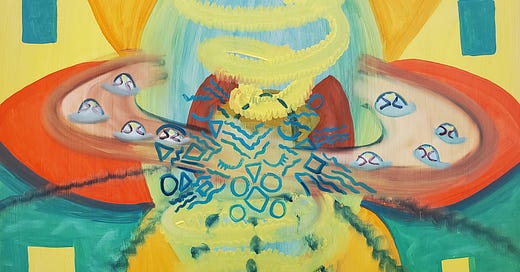My Personal Red Book Excerpt: The Unconscious Orbit
A therapeutic art journey through Jungian symbolism, unveiling layers of meaning in the canvas of personal transformation.
Fig. 1 The Unconcious Orbit, Oil on Panel, 24” x 30”, ©Theresa Slater 2024
“But when God rested in the egg and awaited his beginning, my force went into him….I did not know what was happening to me since simply everything powerful, beautiful, blissful, and superhuman had leaked from my maternal womb; none of the radiant gold remained…I was left with the broken shells and the miserable casings of his beginning; the emptiness of the depths opened beneath me.” (Jung 2009, p. 309)
For the artwork component of this newsletter, I focused on Jung’s symbolic unconscious, seeking to uncover hidden meanings of my inner world on the panel. My artistic process lacked preconceived images; instead, I allowed myself to respond intuitively to each mark I made. The emerging symbols would serve as reflections of my journey toward wholeness. Kast resonated with my approach: "To symbolize is to discover the hidden meaning in a concrete situation" (Kast 1992, p. 14).
Following the creation of my artwork, I engaged in a reflective dialogue with the images, posing questions that would unveil the meanings embedded within. “To enable a picture to start to talk to us «out of itself,» we have to ask the picture questions” (Abt 2005, p. 41). Through this reflective dialogue, I encountered my first subjective experience, a gut reaction of embarrassment, as the artwork implied chaos in my inner life.
I scrutinized the compositional and formal details, considering the quality of the medium, format, and colours. The central figure in the painting, surrounded by orbiting moons or eggs, becomes a focal point. It is a self-portrait. The symbolic language depicted a face of asemic writing extends the orbit, dividing the canvas into the conscious and unconscious realms. Despite the chaotic representation of my inner life through the busy lines, I found the aesthetics energizing. The vibrational mark-making contributed to an overall boost in energy.
On the other hand, thinking about assessing the structural congruence of the elements, I ask, “Are things congruent?” (Abt 205, p. 43). The artwork, designed to resemble a tarot spread, left the cards unturned, representing archetypes I imagine to be the Magician, Hierophant, Sun, and Star.
“Is the picture hinting at something to worry about?” (Abt 2005, p. 43) Intuitive perception emanating from the unconscious hinted at concerns related to child-rearing. The symbolism of orbiting spheres as eggs reflected the feeling of being out of control in this aspect of my life. As this therapeutic art dialoguing unfolded, there was an emotional confrontation between consciousness and the unconscious (Kast 1992, p. 27).
The unexpected meaning of the spheres as symbols of my worry about not having children surprised me. Goldstein's words on symbols as agents of change and transformation resonated deeply, emphasizing their ability to provoke emotional reactions and curiosity (Goldstein 1999, p. 155-156).
According to Abt, as the inner symbols and their meanings became conscious, the next step involved reuniting this newfound insight with individual reality (Abt 2005, p. 32). Confronting the worry about not having children, I am now conscious and must attend to it.
The question arises: is the artwork I created truly art? Foster suggests that pictures made in art therapy may not be considered great art but emphasize their significance in the therapeutic context (Foster 2020, p. 80). Following Jung's advice to document the experience beautifully becomes a guiding principle, whether deemed art or not (Foster 2020, p. 81).
My artistic journey into symbolic unconsciousness has uncovered layers of meaning within my inner world. The artwork, a reflection of my exploration towards wholeness, is therapeutic, bridging the realms of consciousness and the unconscious. As I navigate the symbolic language of my creation, I am reminded that beauty lies not just in the artwork itself but in the profound process of self-discovery and expression.
If you were to create a symbolic self-portrait, what elements and symbols might you include?
Can you recall a moment when a creative expression or symbol unexpectedly revealed deeper personal insights for you?
References
Abt, T. (2005). Introduction to picture interpretation: According to C. G. Jung (1. ed). Living Human Heritage Publ.
Goldstein, R., & Bach, S. R. (1999). Images, meanings and connections: Essays in memory of Susan R. Bach. Daimon.
Jung, C. G., & Shamdasani, S. (Ed.). (2009). The red book: Liber Novus.
Kast, V., & Kast, V. (1992). The dynamics of symbols: Fundamentals of Jungian psychotherapy (1st U.S. ed). Fromm International Pub. Corp.
Swan-Foster, N. (2020). C. G. Jung’s Influence on Art Therapy and the Making of the Third. Psychological Perspectives, 63, 67–94. https://doi.org/10.1080/00332925.2020.1739467




